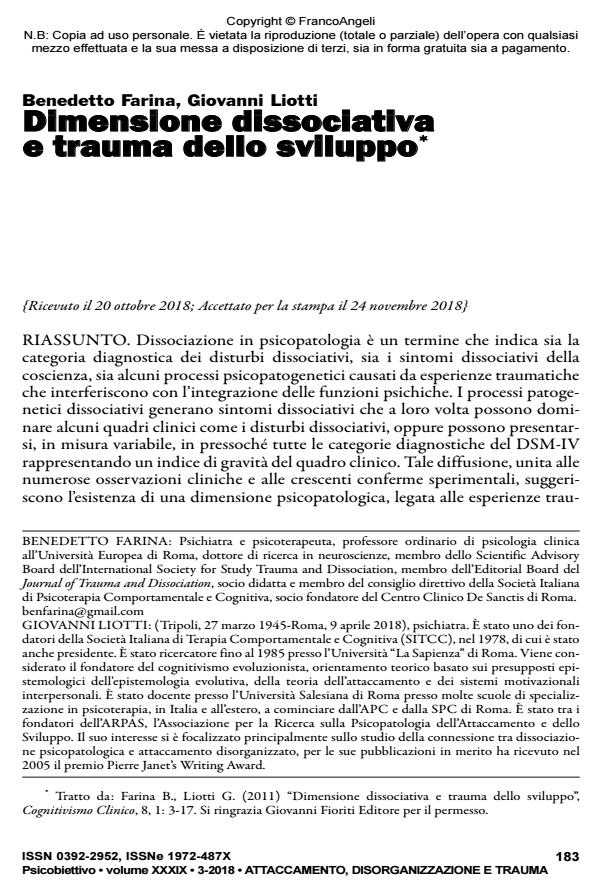Dissociative psychopathological dimension and developmental trauma
Journal title PSICOBIETTIVO
Author/s Benedetto Farina,, Giovanni Liotti
Publishing Year 2018 Issue 2018/3
Language Italian Pages 13 P. 183-195 File size 152 KB
DOI 10.3280/PSOB2018-003018
DOI is like a bar code for intellectual property: to have more infomation
click here
Below, you can see the article first page
If you want to buy this article in PDF format, you can do it, following the instructions to buy download credits

FrancoAngeli is member of Publishers International Linking Association, Inc (PILA), a not-for-profit association which run the CrossRef service enabling links to and from online scholarly content.
Dissociation is a term indicating Dissociative Disorders DSM category, a cluster of symptoms and trauma based psychopathological processes hampering the integration of mental functions. Dissociative processes cause dissociative symptoms that could dominate some disorders like Dissociative Disorders but also spread to other disorders worsening the prognosis. The wide diffusion of dissociative symptomatology in many disorders, clinical observations and supporting experimental data about the effects of childhood adversities, suggest the presence of a dimensional psychopathology associated with developmental trauma worsening therapies outcome and that requires specific skills for an appropriate treatment.
Keywords: Dissociation; Developmental Trauma; Attachment Disorganization; Complex PTSD
- Frailty in Children Giovanna Perricone, pp.223 (ISBN:978-3-031-24306-6)
- Functional seizures and binge eating disorder: A cross-sectional study Anna Mammì, Valentina Bova, Iolanda Martino, Ilaria Sammarra, Edoardo Ferlazzo, Angelo Pascarella, Domenico Abelardo, Oreste Marsico, Claudia Torino, Vittoria Cianci, Giulia Viola, Valeria Pecoraro, Massimiliano Beghi, Antonio Gambardella, Arturo Pujia, Umberto Aguglia, Sara Gasparini, in Epilepsy & Behavior 109943/2024 pp.109943
DOI: 10.1016/j.yebeh.2024.109943
Benedetto Farina,, Giovanni Liotti, Dimensione dissociativa e trauma dello sviluppo in "PSICOBIETTIVO" 3/2018, pp 183-195, DOI: 10.3280/PSOB2018-003018